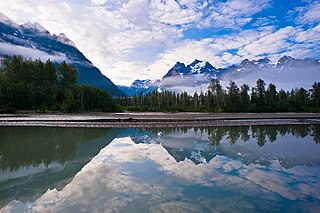 W
WA wood waste burner, known as a teepee burner or wigwam burner in the United States and a beehive burner in Canada, is a free-standing conical steel structure usually ranging from 30 to 60 feet in height. They are named for their resemblance to beehives, teepees or wigwams. A sawdust burner is cylindrical. They have an opening at the top that is covered with a steel grill or mesh to keep sparks and glowing embers from escaping. Sawdust and wood scraps are delivered to an opening near the top of the cone by means of a conveyor belt or Archimedes' screw, where they fall onto the fire near the center of the structure.
 W
WThe Coastal GasLink pipeline is a TC Energy natural gas pipeline under construction in British Columbia, Canada. Starting in Dawson Creek, the pipeline's route crosses through the Canadian Rockies and other mountain ranges to Kitimat, where the gas will be exported to Asian customers. Its route passes through several First Nations peoples' traditional lands, including some that are unceded. Although approved by 20 First Nations' elected councils, the hereditary chiefs of the Wetʼsuwetʼen people withheld their approval on ecological grounds and organized a blockade of construction within the Wetʼsuwetʼen peoples' traditional lands.
 W
WThe Great Bear Rainforest is a temperate rain forest on the Pacific coast of British Columbia, Canada comprising 6.4 million hectares. It is part of the larger Pacific temperate rainforest ecoregion, which is the largest coastal temperate rainforest in the world.
 W
WGreat Lakes Areas of Concern are designated geographic areas within the Great Lakes Basin that show severe environmental degradation. There are a total of 43 areas of concern within the Great Lakes, 26 being in the United States, 17 in Canada, with five shared by the two countries.
 W
WHydraulic fracturing in Canada was first used in Alberta in 1953 to extract hydrocarbons from the giant Pembina oil field, the biggest conventional oil field in Alberta, which would have produced very little oil without fracturing. Since then, over 170,000 oil and gas wells have been fractured in Western Canada. Hydraulic fracturing is a process that stimulates natural gas or oil in wellbores to flow more easily by subjecting hydrocarbon reservoirs to pressure through the injection of fluids or gas at depth causing the rock to fracture or to widen existing cracks. New hydrocarbon production areas have been opened as hydraulic fracturing stimulating techniques are coupled with more recent advances in horizontal drilling. Complex wells that are many hundreds or thousands of metres below ground are extended even further through drilling of horizontal or directional sections. Massive fracturing has been widely used in Alberta since the late 1970s to recover gas from low-permeability sandstones such as the Spirit River Formation. The productivity of wells in the Cardium, Duvernay, and Viking formations in Alberta, Bakken formation in Saskatchewan, Montney and Horn River formations in British Columbia would not be possible without hydraulic fracturing technology. Hydraulic fracturing has revitalized legacy oilfields. "Hydraulic fracturing of horizontal wells in unconventional shale, silt and tight sand reservoirs unlocks gas, oil and liquids production that until recently was not considered possible." Conventional oil production in Canada was on a decrease since about 2004 but this changed with the increased production from these formations using hydraulic fracturing. Hydraulic fracturing is one of the primary technologies employed to extract shale gas or tight gas from unconventional reservoirs.
 W
WRivers Without Borders is a nonprofit organization fiscally sponsored by the Tides Center in the United States. Rivers Without Borders works as a project of Tides Canada Initiatives in Canada. Tides Canada's mission is to provide uncommon solutions for the common good by leading and supporting actions that foster a healthy environment and just Canadian society.
 W
WThe Sacred Headwaters is a large subalpine drainage basin centred around Klappan Mountain of the Klappan Range in northern British Columbia. It is the source of three wild salmon rivers: the Skeena River, Nass River, and Stikine River. It is also referred to as the Klappan Valley, although the Klappan—a tributary of the Stikine River—is only one of the area's watersheds. Local Tahltan people call the area Klabona, which is loosely translated as "headwaters."
 W
WBelow is a brief timeline covering the history of the petroleum industry Alberta and its predecessor states.